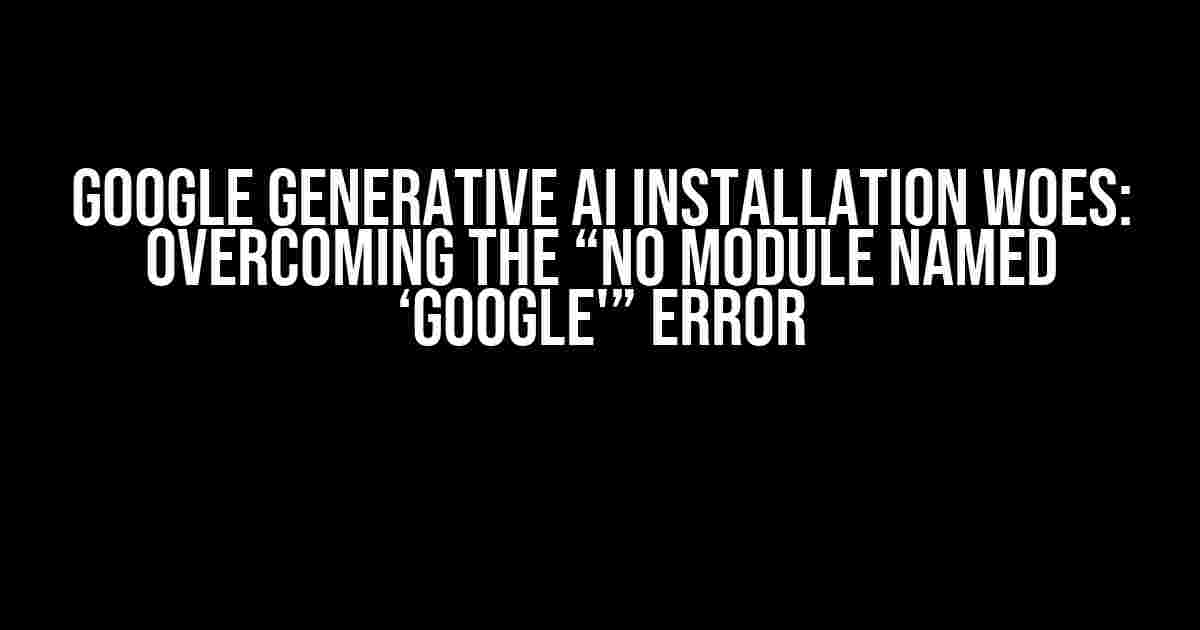If you’re reading this, chances are you’ve excitedly installed the Google Generative AI library, only to be greeted by the frustrating “No module named ‘google'” error. Don’t worry, friend, you’re not alone! In this article, we’ll dive into the possible causes and provide a step-by-step guide to get you up and running with Google Generative AI in no time.
What’s the Deal with the “No Module Named ‘google'” Error?
The “No module named ‘google'” error typically occurs when Python can’t find the Google library, even though you’ve installed it. There are a few reasons why this might happen:
- Incorrect Installation: You might have installed the library incorrectly, or the installation process didn’t complete successfully.
- Python Version Issues: You’re using a Python version that’s not compatible with the Google Generative AI library.
- Virtual Environment Mishaps: You’re working in a virtual environment, but the Google library isn’t installed or activated correctly.
- Dependency Conflicts: There’s a conflict between the Google library and another installed package.
Step-by-Step Troubleshooting Guide
Let’s tackle each potential issue one by one:
1. Reinstall the Google Generative AI Library
Try reinstalling the library using pip:
pip uninstall google-generativeai
pip install google-generativeaiIf you’re using a virtual environment, make sure to activate it before reinstalling the library.
2. Check Your Python Version
Verify that you’re using a compatible Python version. You can check your Python version using:
python --versionThe Google Generative AI library supports Python 3.7 and later. If you’re using an earlier version, upgrade to a compatible one.
3. Virtual Environment Troubleshooting
If you’re working in a virtual environment, ensure that:
- You’ve activated the virtual environment before installing the Google library.
- The Google library is installed within the virtual environment.
- You’re running your Python script within the activated virtual environment.
To check if the Google library is installed in your virtual environment, run:
pip list google-generativeaiIf the library isn’t listed, install it within the virtual environment.
4. Dependency Conflicts
Try uninstalling any recently installed packages that might be causing conflicts:
pip uninstall Then, reinstall the Google Generative AI library.
Additional Tips and Tricks
To avoid future installation woes, consider the following best practices:
| Tips | Explanation |
|---|---|
| Use a Virtual Environment | Create a virtual environment for each project to isolate dependencies and avoid conflicts. |
| Specify Library Versions | When installing libraries, specify the version to ensure compatibility and avoid version conflicts. |
| Use Pip’s –User Flag | When installing libraries, use the –user flag to install packages in your user directory, avoiding system-wide installations. |
| Regularly Update pip | Regularly update pip to ensure you have the latest package information and to avoid installation issues. |
Conclusion
The “No module named ‘google'” error can be frustrating, but it’s often a simple issue to resolve. By following this troubleshooting guide and adhering to best practices, you’ll be well on your way to harnessing the power of Google Generative AI in your projects. Remember to stay calm, patient, and methodical when troubleshooting, and don’t hesitate to reach out if you need further assistance.
Happy coding, and may the AI be with you!
FAQs
If you’re still encountering issues, check out these frequently asked questions:
- Q: I’ve tried everything, but I still get the “No module named ‘google'” error. What’s next?
A: Try reinstalling Python, or seek help from the Google Generative AI community or a Python expert.
- Q: I’m using a Google Colab notebook. Do I need to install the Google Generative AI library?
A: No, the Google Generative AI library is pre-installed in Google Colab. You can use it directly.
- Q: Can I use the Google Generative AI library with Python 2.x?
A: No, the Google Generative AI library only supports Python 3.7 and later.
We hope this comprehensive guide has helped you overcome the “No module named ‘google'” error and get started with Google Generative AI. Happy coding!
Frequently Asked Question
Getting started with Google’s Generative AI, but stuck with an error? Don’t worry, we’ve got you covered!
Q1: I’ve installed google-generativeai, but I get an error saying “No module named ‘google'”. What’s going on?
This error usually occurs when there’s a conflict with the module name. Try uninstalling and reinstalling the google-generativeai package. Make sure you’re using the correct Python environment and package manager (e.g., pip). If the issue persists, try renaming the import statement to `import google_ai_generative` instead of `import google`.
Q2: I’ve checked my Python environment, and everything seems fine. What else could be causing the issue?
A common culprit is a naming conflict with another package or module. Try renaming your Python script or file to something other than `google.py`. Also, ensure you’re not using `google` as a variable name anywhere in your code. If you’re still stuck, try reinstalling the package in a fresh Python environment.
Q3: Is it possible that I’m using an outdated version of the google-generativeai package?
You’re on the right track! Yes, an outdated package version can cause this error. Run `pip install –upgrade google-generativeai` to ensure you’re using the latest version. You can also check the package version by running `pip show google-generativeai`. If you’re still facing issues, try reinstalling the package.
Q4: I’m using a virtual environment, but I still get the “No module named ‘google'” error. What’s going on?
Virtual environments can sometimes cause package installation issues. Try activating your virtual environment and then install the package using `pip install google-generativeai`. If you’re still facing issues, try creating a new virtual environment and install the package from scratch.
Q5: I’ve tried everything, but the error persists. Where can I get more help?
Don’t give up just yet! You can try searching for answers on the official Google Generative AI GitHub page or Stack Overflow. You can also reach out to the Google Generative AI community or create a new issue on the GitHub page. We’re here to help you get started with this awesome AI tool!
